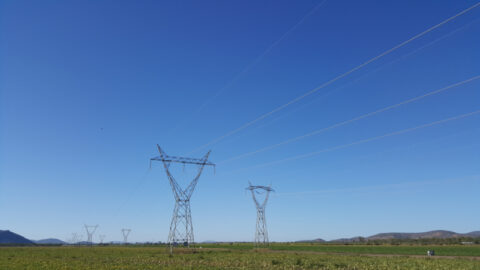As one of Australia’s leading providers of high voltage electricity transmission network services, Powerlink undertakes an extensive program of works annually to ensure its network operates safely and reliably.
Powerlink owns, develops, operates and maintains the high voltage electricity transmission network in Queensland. Its network extends 1,700 kilometres from Cairns to the New South Wales border, and comprises 15,345 circuit km of transmission lines and 147 substations.
Powerlink’s purpose is to connect Queenslanders to a world-class energy future. This includes delivering a significant program of work annually to ensure existing assets are operating safely and securely, and new assets are added to the network as needed to cater to new customers in emerging markets.
For works relating to substations, Powerlink has a Substation Panel Agreement (SPA) with a number of contractors. Under the SPA, when new works are required, Powerlink releases a tender to members of the SPA for them to quote on. Zinfra, as a member of the SPA, has been involved in a number of substation works and upgrades in recent years.

132kV Yard. Image: Zinfra
Communication the key to success
Zinfra and Powerlink have partnered on several projects together in recent years. This includes partnering on projects to upgrade or install new equipment at the Baralaba, Ingham, Swanbank and Mudgeeraba substations.
Currently, the Zinfra team is delivering a 275/132kV T2 transformer at Strathmore substation in Northern Queensland. Three separable portions of works have been completed in 2022 with decommissioning works to take place in 2023.
Works for this project began in October 2021 after Zinfra were awarded the project. The scope of works included extension of the 132kV switchyard bench, secondary systems upgrade in the 132 and 275kV switchyards, oversee the delivery and assembly of the 275/132kV 300 MVA transformer and installing a new 132kV transmission line between the 275kV switchyard and the 132kV switchyard.
For Zinfra Project Manager, Edward Olivier, communication is a core to the working relationship between Zinfra and Powerlink, from the first project undertaken under the SPA to the current project at Strathmore.
“Communication is key and it’s probably the biggest task of a project manager,” Mr Olivier said.
“There are a lot of parties involved in these projects, so it’s important that everyone talks to each other.
“We also formalise the channels of communication with a communication matrix that determines the different roles in the two organisations, and the roles of individuals within each organisation, so we know exactly who is responsible for what.”
But for the works on the ground, the most important communication has been day-to-day catch ups with members from all levels of both organisations.
“In terms of communication, it’s regular conversations, weekly catch ups, monthly reports – open and honest communication with a lot of trust and early advice.”
Risk management with everyone onboard
Clear and regular communication has improved how Zinfra and Powerlink approach risk management during these works, particularly at Strathmore.
After Powerlink awarded Zinfra the contract, Zinfra had to submit a health and safety management plan and environment management plan, which needed general and project-specific details regarding potential risks, constraints and appropriate actions. This was all compiled in a risk register.
To ensure the risk register covered everything before mobilisation, Zinfra conducted a Construction Risk Assessment Workshop (CRAW) with Powerlink, then after that the register is reviewed and updated every month to check for any changes.
Creating plans to tackle risks involved Zinfra and Powerlink turning to personnel from all levels to ensure that everything in the risk register and protocols on-site were up-to-date.
“Anyone can stop a task to assess the risks appropriately and make sure that controls are in place,” Mr Olivier said.
“The risk register is part of the process and protocols we’re expected to follow, but there’s also background management plans and then down on the site level is the daily pre-starts, swims and toolbox meetings.”
This meant as issues arose during the process, consultation and planning helped to resolve issues before they could impact on work delivery or team member safety.

Transformer complete on pad. Image: Zinfra
Responding to unexpected weather
Zinfra’s preparation and openness proved useful when a heatwave that wasn’t typical for Far North Queensland occurred during the works at Strathmore.
As a result, site managers had to be prepared to tackle exhaustion, heatstroke and potential equipment failures. There were periods when a decision was made to stop works, reassess the situation and devise a plan.
While Zinfra utilised the already prepared risk register, the team also needed to draw expertise from other professionals as the risk management process did not factor in an unprecedented and unexpected heatwave.
Zinfra proactively engaged an external subject matter expert to undertake a real-time body core temperature study involving field personnel. This study resulted in the implementation of additional controls and protocols to effectively manage the risk of heat stress on its workforce. These controls and protocols have now been implemented into our management plans across all projects.
Demonstrating the ability to deliver
Even in challenging conditions, Zinfra kept everyone informed and collaborated to find the best solution, rather than impact on work quality or safety on site.
“Our approach is to manage the risk, plan the work and consult with each other on what is the best way to avoid any issues or safety concerns around carrying out the activities,” Mr Olivier said.
“For Zinfra, we do it once and we do it properly the first time.”
This sponsored editorial was brought to you by Zinfra. For more information, go to: https://www.zinfra.com.au/

















